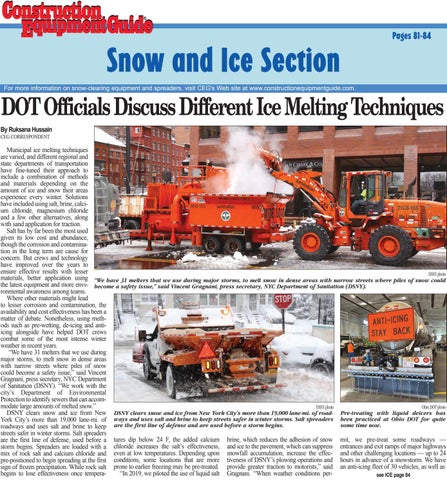Pages 81-84
Snow and Ice Section For more information on snow-clearing equipment and spreaders, visit CEG's Web site at www.constructionequipmentguide.com.
DOT Officials Discuss Different Ice Melting Techniques By Ruksana Hussain CEG CORRESPONDENT
Municipal ice melting techniques are varied, and different regional and state departments of transportation have fine-tuned their approach to include a combination of methods and materials depending on the amount of ice and snow their areas experience every winter. Solutions have included using salt, brine, calcium chloride, magnesium chloride and a few other alternatives, along with sand application for traction. Salt has by far been the most used given its low cost and abundance, though the corrosion and contamination in the long term are cause for concern. But crews and technology have improved over the years to ensure effective results with lesser DSNY photo materials, better application using “We have 31 melters that we use during major storms, to melt snow in dense areas with narrow streets where piles of snow could the latest equipment and more envi- become a safety issue,” said Vincent Gragnani, press secretary, NYC Department of Sanitation (DSNY). ronmental awareness among teams. Where other materials might lead to lesser corrosion and contamination, the availability and cost effectiveness has been a matter of debate. Nonetheless, using methods such as pre-wetting, de-icing and antiicing alongside have helped DOT crews combat some of the most intense winter weather in recent years. “We have 31 melters that we use during major storms, to melt snow in dense areas with narrow streets where piles of snow could become a safety issue,” said Vincent Gragnani, press secretary, NYC Department of Sanitation (DSNY). “We work with the city’s Department of Environmental Protection to identify sewers that can accommodate large amounts of melted snow.” DSNY photo Ohio DOT photo DSNY clears snow and ice from New DSNY clears snow and ice from New York City’s more than 19,000 lane-mi. of road- Pre-treating with liquid deicers has York City’s more than 19,000 lane-mi. of ways and uses salt and brine to keep streets safer in winter storms. Salt spreaders been practiced at Ohio DOT for quite some time now. roadways and uses salt and brine to keep are the first line of defense and are used before a storm begins. streets safer in winter storms. Salt spreaders are the first line of defense, used before a tures dip below 24 F, the added calcium brine, which reduces the adhesion of snow mit, we pre-treat some roadways — storm begins. Spreaders are loaded with a chloride increases the salt’s effectiveness, and ice to the pavement, which can suppress entrances and exit ramps of major highways mix of rock salt and calcium chloride and even at low temperatures. Depending upon snowfall accumulation, increase the effec- and other challenging locations — up to 24 pre-positioned to begin spreading at the first conditions, some locations that are more tiveness of DSNY’s plowing operations and hours in advance of a snowstorm. We have sign of frozen precipitation. While rock salt prone to earlier freezing may be pre-treated. provide greater traction to motorists,” said an anti-icing fleet of 30 vehicles, as well as “In 2019, we piloted the use of liquid salt Gragnani. “When weather conditions perbegins to lose effectiveness once temperasee ICE page 84



